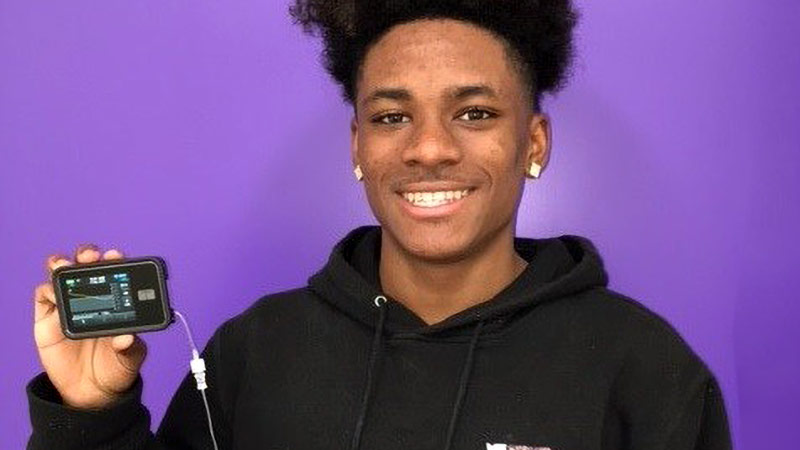What is Diabetes (Type 1)?
Type 1 diabetes, or insulin-dependent diabetes, is an incurable auto-immune disease (this means the body attacks itself). In this case the body is attacking its own pancreas, specifically the insulin-producing cells in the pancreas, stopping the production of insulin (a hormone). Our bodies need insulin in order to use the glucose (sugar) our body obtains from food. Without insulin, glucose cannot enter our cells to be used as energy. Therefore, the glucose remains in the bloodstream. High levels of glucose in the bloodstream cause damage to blood vessels. All of our organs (heart, brain, kidneys, etc.) need blood vessels in order to function properly. This is why many other medical conditions are associated with diabetes. Examples are: heart attack, stroke, kidney failure, and circulatory problems.
What are the causes?
- Family history – the risk of having Type 1 diabetes can be inherited
- Environmental trigger – something that triggers the body to mistakenly destroy cells in the pancreas
- Unknown factors – doctors do not know all of the causes of the disease
What can I do?
- Understand your child’s insulin therapy. Type 1 diabetes will only remain under control with insulin replacement therapy.
- Monitor your child’s blood sugar regularly and teach your child how to use the monitor
- Encourage regular exercise and a healthy diet
What is an emergency?
A diabetes emergency occurs when there is a severe imbalance between the amount of insulin and the amount of glucose in the body. A child experiences hyperglycemia when there is a high level of sugar (glucose) and a low level of insulin in the body. A child experiences hypoglycemia when there is a low level of sugar (glucose) and a high level of insulin in the body.
Signs of an emergency include:
- Shaking and confusion
- Abdominal pain
- Rapid breathing
- Fruity (sugary) smell to the breath
- Rarely – loss of consciousness
What is Diabetes (Type 2)?
Type 2 diabetes, previously known as non-insulin dependent diabetes, is the most common form of diabetes in the world. Our bodies need insulin (a hormone) in order to use the glucose (sugar) our body obtains after digesting food. In Type 2 diabetes, the body cannot use its own insulin properly or the body does not produce enough insulin to deliver glucose to the cells. This is called insulin resistance. High levels of glucose build up in the bloodstream and cause damage to blood vessels. All of our organs (heart, brain, kidneys, etc.) need blood vessels in order to function properly. This is why many other medical conditions are associated with diabetes. Examples are: blindness, kidney failure, heart disease, circulatory problems and nerve damage.
What are the risk factors?
- Family history of diabetes
- Having excess weight, especially around the abdomen
- Female birth-sex
- Specific ethnic groups (American Indian, African-American, Asian, or Hispanic/Latine)
- Other conditions with insulin resistance
What can I do?
- Evaluate your child's nutrition. Make adjustments as needed to provide daily vegetables and fruits, lean proteins, and water for hydration. Decrease processed foods and sweetened beverages
- Establish and/or increase regular exercise (at least 30 minutes per day)
- Understand your child’s medications
What is an emergency?
A diabetes emergency occurs when there is a severe imbalance between the amount of insulin and the amount of glucose in the body. A child experiences hyperglycemia when there is a high level of sugar (glucose) and a low level of insulin in the body. A child experiences hypoglycemia when there is a low level of sugar (glucose) and a high level of insulin in the body.
Signs of an emergency include:
- Shaking and confusion
- Abdominal pain
- Rapid breathing
- Fruity (sugary) smell to the breath
- Rarely – loss of consciousness
It is important to remember the health information found on this Web site is for reference only not intended to replace the advice and guidance of your health care provider. Always seek the advice of your physician with any questions you may have regarding a medical condition. If you think you may have a true medical emergency, call 911 immediately.
Symptoms
Symptoms of Diabetes include:
- Increased thirst
- Dry mouth
- Frequent urination
- Increased hunger (even after eating)
- Nausea (sometimes vomiting)
- Abdominal pain
- Unexplained weight loss (without trying to lose weight)
- Fatigue (tiredness and weakness)
- Blurred vision
- Heavy, labored breathing
- Frequent infections of the skin, urinary tract, or vagina
Centers & Programs
Our Diabetes Program helps families learn how to manage Type 1 or Type 2 diabetes, and reduce the risk of associated complications.



